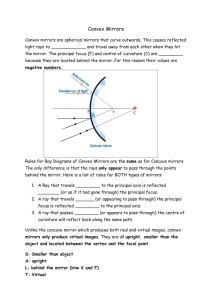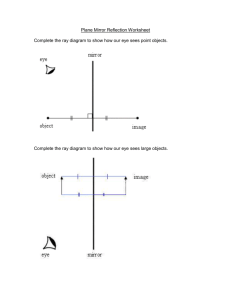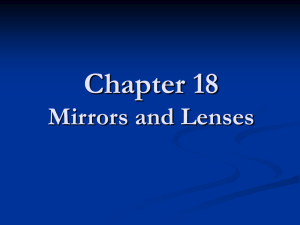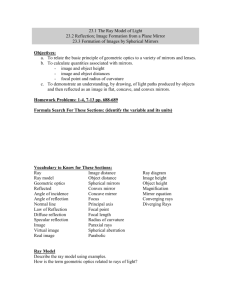PowerPoint
advertisement
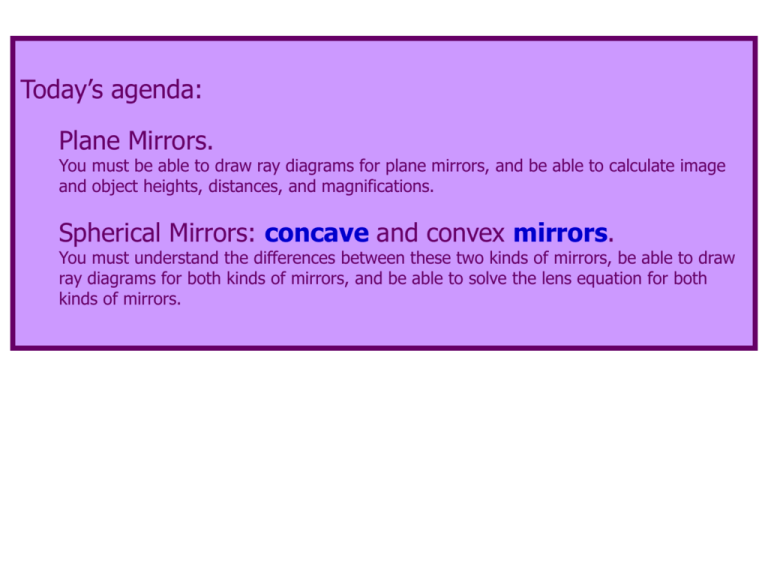
Today’s agenda: Plane Mirrors. You must be able to draw ray diagrams for plane mirrors, and be able to calculate image and object heights, distances, and magnifications. Spherical Mirrors: concave and convex mirrors. You must understand the differences between these two kinds of mirrors, be able to draw ray diagrams for both kinds of mirrors, and be able to solve the lens equation for both kinds of mirrors. Concave and Convex Mirrors There are two kinds of spherical mirrors: concave and convex. concave F convex Ray Diagrams for Mirrors We can use three “principal rays” to construct images. In this example, the object is “outside” of F. Ray 1 is parallel to the axis and reflects through F. Ray 2 passes through F before reflecting parallel to the axis. Ray 3 passes through C and reflects back on itself. A fourth principal ray is the one directed at the vertex V. C F V Ray Diagrams for Concave Mirrors We use three “principal rays” to construct images. An image is formed where the rays converge. The image from a concave mirror, object outside the focal point, is real, inverted, and smaller than the object. C F Two rays would be enough to show us where the image is. We include the third ray for “safety.” You don’t have to use principal rays, but they are easiest to trace. “Real” image: you could put a camera there and detect the image. The image from a concave mirror, object inside the focal point, is virtual, upright, and larger than the object. Ray 1: parallel to the axis then through F. Ray 2: “through” F then parallel to the axis. Ray 3: “through” C. What do you mean, this is a virtual image? I can see it! C F With this size object, there was a bit of spherical aberration present, and I had to “cheat” my C a bit to the left to make the diagram look “nice.” You could show that if an object is placed at the focal point, reflected rays all emerge parallel, and *no image is formed. Ray 1: parallel to the axis then through F. Ray 2: “through” F then parallel to the axis. Can’t do! Ray 3: through C. no image C Worth thinking about: what if the object is placed between F and C? F *Actually, the image is formed at infinity. The Mirror Equation With a bit of geometry, you can show that 1 1 1 f= for a flat mirror. + = s s' f The magnification is the ratio of the image to the object y height: y' s' m= = y s s f C y’ F s’ 1 1 1 + = s s' f y' s' m= = y s Sign conventions for the mirror equation: When the object, image, or focal point is on the reflecting side of the mirror, the distance is positive. When the object, image, or focal point is “behind” the mirror, the distance is negative. s f y C y’ F The image height is positive if the image is upright, and negative if the image is inverted relative to the object. s’ “When the object, image, or focal point is “behind” the mirror, the distance is negative.” If the image distance is negative, can the image be real? Handy quick reference card from Dr. Hale: http://web.mst.edu/~hale/courses/Physics24/Quick.Reference.Cards/Card.5.mirror.lens.pdf Example: a dime (height is 1.8 cm) is placed 100 cm away from a concave mirror. The image height is 0.9 cm and the image is inverted. What is the focal length of the mirror. y=1.8 y’=-0.9 s=100 y' s' m= = y s -0.9 s' -0.9 = s' = - 100 = +50 cm 1.8 100 1.8 1 1 1 1 1 1 2 3 = + = + = + = f s s' 100 50 100 100 100 f= 100 = 33.3 cm 3 Example: a dime (height is 1.8 cm) is placed 100 cm away from a concave mirror. The image height is 0.9 cm and the image is inverted. What is the focal length of the mirror. 1 1 1 + = s s' f y' s' m= = y s s f y C y’ s’, s, or f on reflecting side are + y is – if image is inverted F s’ f = 33.3 cm Applications of concave mirrors. Shaving mirrors. Makeup mirrors. Kid scarers. Solar cookers. Ant fryers. Flashlights, headlamps, stove reflectors. Satellite dishes (when used with electromagnetic radiation).
